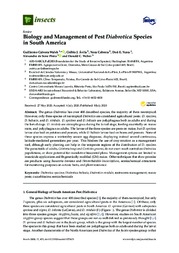Biology and Management of Pest Diabrotica Species in South America.
Biology and Management of Pest Diabrotica Species in South America.
Author(s): CABRERA WALSH, G.; AVILA, C. J.; CABRERA, N.; NAVA, D. E.; PINTO, A. de S.; WEBER, D. C.
Publication year: 2020
Types of publication: Journal article
Keywords: Biologia, Corn, Diabrotica, Diabrotica Speciosa, Diabrotica balteata, Diabrotica viridula, Manejo, Milho, Pests, Praga de Planta, Rootworms
Observation
Some of Embrapa's publications are published as ePub files. To read them, use or download one of the following free software options to your computer or mobile device. Android: Google Play Books; IOS: iBooks; Windows and Linux: Calibre.
Access other publications
Access the Agricultural Research Database (BDPA) to consult Embrapa's full library collection and records.
Visit Embrapa Bookstore to purchase books and other publications sold by Embrapa.

